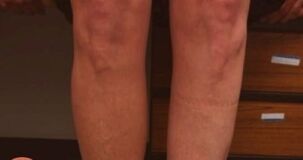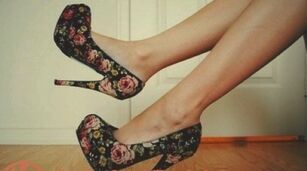Varicose veins are a common medical process associated with varicose veins, nodules, and blood stasis. The varicose veins of the inner leg are characterized by the nodular structure of the epidermal veins. In the early stages of the disease, there are no symptoms. Many people have a question about what should be treated of this disease.
What is this disease?

Varicose veins of the lower extremities is a very dangerous disease that can cause death. This is a pathological lesion of the organs of the circulatory system. With complications of the disease, a prolonged and irreversible prolonged process of the veins is observed.
The nodules begin to form in capillaries that interfere with the normal flow of blood. With varicose veins of deep veins, the walls of the veins dilate greatly, making the valves function poorly. For this reason, blood starts to build up in the legs.The disease mainly affects people aged 30 to 40 years.
Development reason
The causes of this disease can be very different. Among them are:
- genetic factors (possible birth defect or weakening of venous cells);
- is more common in women (in women, the disease is observed much more often due to the use of hormonal drugs, the risk also increases due to delayed childbirth);
- increased pressure inside the veins (this is due to an inactive lifestyle, when overweight);
- presence of nerve endocrine changes; a mechanical obstacle to normal blood circulation (this can be facilitated by repeatedly compressing the extremities);
- presence of allergic reactions;
- changes in the immune system;
- disorders in the functioning of valves of the venous system; This
- can start to develop as a result of cellulite or dermatitis.
Before proceeding with treatment, it is imperative to determine the root cause of the disease. An experienced vein therapist will help you with this.
Symptoms and manifestations of varicose veins inside
It is important to see a doctor promptly,if varicose veins of the lower extremities appear. Symptoms of this disease in the early onset of varicose veins will be as follows:

- with swelling of the extremities at the end of the day(this symptom is found in the ankles and feet, edema may also appear in the lower half of the legs);
- patient has a heaviness in calf muscles(a feeling of bloating occurs after walking or standing for a long time, this symptom may appear after a long time in the quads. sitting posture).
A characteristic feature of this disease is the fact thatafter rest, all symptoms disappear without a trace. It also shrinks after a long period of rest.
As varicose veins develop gradually, the following symptoms will begin to appear:
- moderate pain begins to appear in calf muscles, such pains are dull and painful;
- local burning sensation and fatigue;
- excessively dry skin appears, pigmentation spots and the skin begins to harden;
- cramps very often at night; Spider veins
- begin to appear on the epidermis;
- the veins inside the legs, the photos shown below, begin to enlarge significantly, outwardly like bunches of grapes;
- can form small wounds that can heal over a long period of time.
Important!Untimely treated the patient can bring a number of complications. In some cases, death.

After a while, eczema and sores began to appear. Such symptoms are very easy to turn into gangrene. All of this can cause amputation, sepsis or death.
The most dangerous consequence is the appearance of a thrombus, with subsequent cleavage. This becomes the patient's death.
Symptoms and treatment of underlying varicose veins is the question of most concern to many patients.
Methods of treatment
Treatment of varicose veins is carried out with caution and promptly. Treatment of the inner veins of the legs, the symptoms can manifest themselves in different ways, which is carried out only after preliminary diagnosis.The following techniques can be used:
compression- ;
- sclerosis; Drugs
- ;
- surgery.
Compression methodhelps to cope with early stage disease. This treatment involves wearing special compression lingerie every day.
In the case of sclerosis, the veins become blocked. This is due to the introduction of preparations for hardening on it. After such actions, the blood can easily travel through the capillaries without difficulty.
Cautious healing is only effective when the first signs of the disease appear. Among the drugs, venotonics drugs are prescribed to the patient. They help strengthen the blood vessel walls as much as possible.
The self-treatment of varicose veins is forbidden, the symptoms can be mild and vice versa.
Precautions
In order to prevent the formation of varicose veins, it is imperative to know the root cause of this disease and to prevent their development. Precautions are as follows:
- requires constant physical activity (People with sedentary lifestyles are much more susceptible to getting sick. Light exercise It is important to avoid lifting heavy objects. In the case of sedentary, it is necessary to occasionally rest, get up and move to allow blood to circulate normally. );
- must not cross your legs when sitting;
- give up all bad habits;
- pay attention to your diet, refuse to be too fatty and salty;
- to carry out remedies related to endocrine diseases, they lead to the development of varicose veins;
- only use loose shoes, not tight (need to ensure free blood circulation, as well as limit wearing shoes with heels);
- bathing in the ocean, but overheating should be eliminated with solar energy.
Conclusion
It should be noted that if at least one of the symptoms of this disease develops, it is urgent to see a specialist. The doctor will prescribe diagnostic procedures and prescribe the appropriate treatment. Threatening delay with complications.
From the above we can summarize that latent varicose veins is a very dangerous disease that can have undesirable consequences. It is for this reason that if at least one symptom appears it is necessary to seek the help of a doctor. Only a specialist can select the necessary treatment.
Varicose veins inside the leg: symptoms and treatment
The contagious geography of varicose veins covering almost every country in the world, it is one of the oldest known diseases known to mankind. According to health statistics, varicose veins of lower extremities and pelvic organs occurs in 15-17% of the population. Today, patients with this diagnosis account for about 4% of the total number of patients in surgical clinics. According to scientists, this disease is a form of payment for humanity's ability to walk. Join us to explore what is varicose veins, the main symptom of the disease and effective treatment.
Explain the occurrence of the disease
Varicose leg veins is one of the dangerous diseases, the manifestation of which is the expansion of blood vessels deep under the skin in the tissues.
Unfortunately, this disease usually affects young working-age people, and in women, symptoms are much more common. Varicose veins inside the legs are usually accompanied by the outside in the form of strongly protruding bulbous veins with a pronounced blue color.
These varicose symptoms make it difficult to treat. The appearance of the legs with varicose buttons is shown in many photos from medical sites.
Varicose veins in the legs can be an independent disease, but it is usually caused by other diseases, and therefore in modern medicine it is common to divide varicose veins into primary and secondary. The primary causes of varicose veins are weakened veins or other functional diseases, which also cause varicose veins of pelvic organs. Among the main causes of the disease stand out:
- Pregnant.
- Overweight, obesity.
- Long-term load bearing on lower limbs, continuous work on legs or continuous lifting of heavy objects.
- Inherited or congenital weakness of connective tissue of various organs.
- Wear high heels for long periods of time and knit with tight elastic.
- In elderly patients, the formation of internal veins is likely due to hormonal changes in the body.

The development of secondary internal varicose veins is a consequence of changes in the process of venous bleeding in various diseases:
- Post-thrombotic syndrome.
- Deep venous valve failure.
- Tumors of organs have a different etiology.
- Injured to limbs and other organs.
Treatment for primary and secondary varicose veins is different.
Main Features
The consequences of undetected internal varicose veins can be very serious, so it is important to pay attention to the first symptoms of the disease, especially in comparison to other forms of the disease, theymanifest very clearly to the naked eye. The main symptoms of varicose veins of the lower extremities are manifested as follows:
- Very strong calf muscle pain, often so unbearable that patients are forced to regularly take strong pain relievers. These symptoms are the reason for immediate medical attention.
- The venous morphology of the lower extremities in the thigh area becomes pronounced, the veins become convex and tubular, they are easily recognized by palpation.
- Vein morphology is bluish-purple, sometimes black, sometimes purple-red.
- The lower extremities are very swollen, and the swelling does not decrease after a night's sleep.
- At night, after a day of manual work, patients often suffer from calf cramps.
All of these symptoms significantly worsen the patient's quality of life and require immediate medical attention, sometimes only with surgical treatment of the veins.

Clinical Presentation
The severity of symptoms of varicose veins depends on the stage of the disease.
At an early stage, pathological changes in the vascular wall are not detected, the patient develops leg edema at the end of the workday and severe leg pain, but after a night of rest, these unpleasant sensationsdisappear.
Some patients experience mild nausea, this stage of the disease is called "varicose veins in the skin". If treatment is started at this stage of the disease, the prognosis is very favorable, since the valve system of the veins has not been changed and cope with the load, the pathological symptoms will quickly disappear.
In the second stage of the disease, the edema of the lower extremities becomes permanent, the patient complains of persistent heavy leg pain and increased fatigue. Symptoms of varicose veins in this stage of the disease are also manifested by constantly cramping calf muscles, cold limbs.
A photo in medical publications shows blood vessels beginning to appear on the skin on the inner thighs, but their areas of appearance are painless to the touch. At this stage, the formation of veins begins, there may be bleeding from them.
These symptoms increase very quickly and without treatment, the disease progresses to the next stage.
The third stage of varicose veins has been clearly identified with the naked eye, which can be seen in photos from various medical sources.
Varicose veins and enlargement due to a well-defined circulatory disorder under the skin on the calves and inner thighs.
At this stage, in addition to the appearance of nodules, the patient presents with weakness and hair loss, dry skin, and leg muscles are constantly cramps.
The fourth stage of the disease has resulted in serious complications (bleeding, ulcers, etc. ), which can be fatal. You need to start treatment right away, without waiting for severe symptoms.
Complications
These include the following:
Foot skin nutrient ulcers.
This is a very painful complication for the patient, as nutritional sores heal very slowly and the patient feels constant itching and burning in their localized sites.
Photographs clearly show the ulcers that are round, colorful, and have different types of secretions: pus, hemorrhage or serum. They appear on the calves and the inner thighs.
With proper and timely treatment, the sores begin to heal, but without help or inappropriately provided, the patient may develop gangrene which then has to be removed. amputee. Death is also possible.
Bleeding from trauma.
Massive bleeding can result from a rupture of a vessel due to thin veins under constant increased blood pressure or a mild trauma. This syndrome is especially dangerous because bleeding can lead to the death of the patient.
Thrombosis is the result of obstruction and inflammation in the veins of the lower extremities. Thrombosis can present with the naked eye only in the swollen and painful leg.
When forming external venous nodes, thrombosis is accompanied by intense pain in the area of thrombus formation, venous pain when palpable and fever in the area where the thromb is formed.
Thrombosis is life-threatening and requires urgent hospitalization and treatment, as it can cause a heart attack and pulmonary artery blockage in a patient.

Therapeutic Principle
Varicose veins of the legs are difficult to treat and the effectiveness of the therapy largely depends on the stage of the disease.
The general principles of disease treatment include normalizing the hormonal level, optimizing physical performance, and adhering to diet.
If the patient is obese, it is necessary to develop methods to lose weight and monitor the implementation. To normalize the sound of the vessels in the lower extremities, it is recommended to use compressed knitted fabric.
The most effective treatment is surgery, a technique well developed in modern surgery. A possible complication of surgery is bleeding from a vein, but the risk is low.
If for some reason surgical intervention is not possible, such as if the patient is afraid that life-threatening bleeding will begin, then the treatment may be done medically. Use the following classes of drugs:
- Antiplatelet agents - to thin the blood and prevent blood clots.
- Phlebotonics - normalizes blood circulation and prevents edema.
- Nitrate - to relieve pain symptoms.
- Vasoprotectors - to normalize vascular tone.
- Nonsteroidal anti-inflammatory drugs - to reduce platelet adhesion and relieve pain.
Many sources of advice to cure varicose veins with folk remedies, on the Internet you can find many pictures of calves and thighs "before", "after" on the pages of traditional medicine100% cure. Doctors are very wary of such drugs and warn that they can only be used as part of complex therapy.
Varicose veins of the lower extremities is a serious illness that requires prompt and qualified treatment. The first alarm symptoms cannot be ignored. The sooner the patient seeks to the doctor, the higher the effectiveness of treatment is.
Main Characteristic Symptoms
Specialists distinguish three stages of varicose veins of lower extremities - compensatory, compensatory and decompensated.
Suitable for light, medium and heavy courses. In some cases, more than a year has passed from the onset of symptoms to the onset of symptoms.
There was practically nothing to worry about during the compensation process. When the body is overactive, there may be mild pain in the limbs. Swelling in the distance, decreased after sleep.
Some people report feeling like a spider or goosebumps crawling down their legs. This is a consequence of impaired blood flow and tissue nutrition.
The deep vein valve movement is largely intact. Visible superficial changes in the skin and veins are not usually observed.
Decompensated is characterized by a more serious clinical picture. Stains come more and more often. They wear sharp pain daggers. A normal touch can be a daunting task.
Patient is unable to walk normally. The usual shopping trip is debugged to the very end.
The leg is swollen, and the volume of the leg is over a half fold. Usually, such swelling does not subside even after prolonged sleep. Traces of discouraged fingers remained on the shin. Many people reported cramps in calf muscles.
During decompensated periods there are often signs of bleeding, thrombophlebitis and thrombophlebitis, and trophic ulcers.
Complications arising from the development of varicose veins
The most common complication of varicose veins is bleeding. If not diagnosed in time, it can be fatal. Even mild bleeding from varicose veins of the lower extremities can cause irreversible harm. Preventing such defects with conventional packing tape is usually unsuccessful. Many surgeons come to connect blood vessels or clot them.
The second most common complication is adding infection with the development of trophic ulcers. Due to a decrease in tissue organicity, abscesses do not heal over a long period of time, a chronic purulent foci is formed.
Comes with a drunken body, hot fever, heavy sweating. Such wounds take a very long time to heal. It depends on the degree of tissue nutrient disturbance and the depth of the lesion.
The ulcer should not be covered often, as this may cause layers of scabs to begin to form and lead to re-formation of the open wound.
The next most common complication is deep vein thrombosis. When motor function is poor, the blood becomes stagnant and increases the risk of blood clots, which can lead to pulmonary embolism.
Vascular surgeons fear a thrombus will float more, since its distal part tends to rupture and lead to an embolism.
Methods of treatment
Treatment of varicose veins of lower extremities takes place in many stages.
Drug therapy is the most common approach, and can be used at all stages of varicose veins, as well as to prevent blood vessel problems.
The basis of conservative therapy is oral poisoning. They help strengthen the vessel wall, increase elasticity and reduce blood stagnation. It is better to apply them internally and externally at the site of the lesion.
There are several types of underwear that are used for different stages of the disease. Lots of models will be able to fulfill each person's individual wishes, I just have positive reviews.
When worn under clothing, does not cause discomfort or irritation.
A well-balanced diet is one of the most important points in the treatment of varicose veins of the lower extremities. Thoroughly limit salt consumption and large amounts of liquid. The use of natural drinks and fruit juices is desirable.
The diet should be proportional to human energy consumption and contain fewer calories to avoid being overweight. You should limit your intake of greasy, fried, spicy, and sour foods. You need to give priority to vegetables and fruits. Include seafood, fermented dairy dishes and products containing digestible carbohydrates in your diet.
In cases where conservative treatments are not working, surgical techniques must be used. These include both minimally invasive and invasive treatments.
Prevention of disease
Knowing the dangers of deep varicose veins, many people want to take precautions against its emergence. To do this, you don't need to follow strict rules, you just need to normalize your lifestyle.
The main precaution is possible regular physical activity.
You can exercise, yoga, walk, swim or even dance to reduce your risk of many diseases.
Also, it's a good idea to give up bad habits completely or at least. Work schedule and rest should be harmonized so that the body can get less rest in a short time.
Very helpful if you adjust your diet except fried, fatty, smoked, pickled, too spicy or salty foods. You need to eat lots of vegetables and fruits.
Regular contrasting showers and relaxing foot baths are good preventive measures.












































